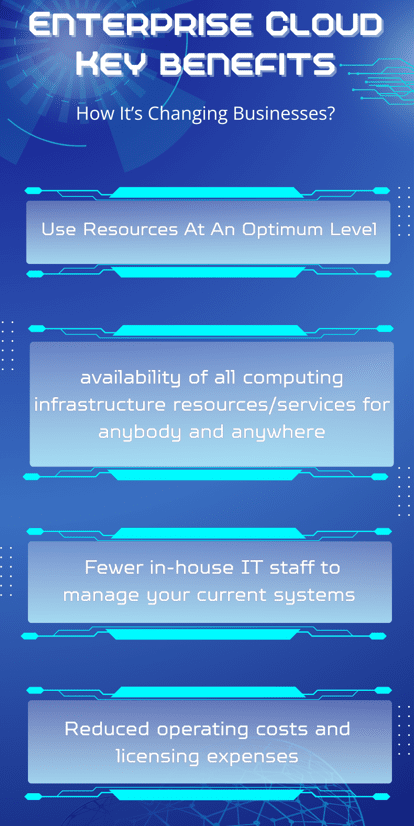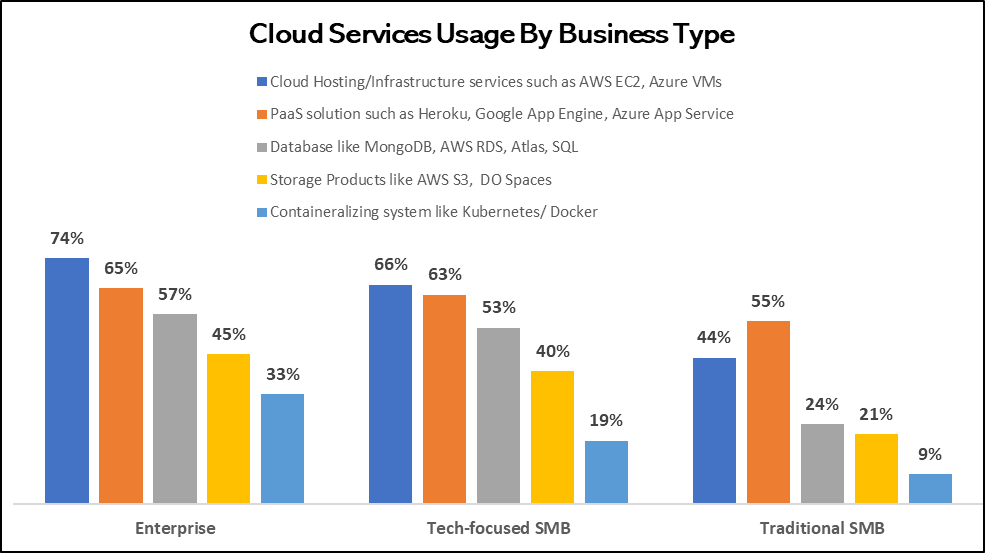Enterprise Cloud is a strategic imperative for modern ventures, especially companies at an enterprise scale. It continues to be a game changer across several industries, and companies are profusely investing in the cloud.
However, any enterprise must have a solid foundation, the proper cloud deployment technology, and advanced complementary tools.
The Cloud: More Than Just a Technology
Table of Contents
Users need not individually manage the cluster of networked elements offering services. Instead, modern companies use an ecosystem of provider-managed software suites and connected hardware. This cluster is packaged as an amorphous cloud, also called an enterprise cloud. Globally, companies spent $94 billion on enterprise cloud in the first quarter of FY 2025—a significant 23% growth, compared to the last quarter (Telecompaper).
The Design of Enterprise Cloud
Enterprise Cloud has additional significant assisting features beyond a scalable cloud infrastructure that offers space and intelligent monitoring. To understand futuristic firms’ more sophisticated cloud designs, you need a thorough understanding of the cloud infrastructure.
The architecture used in Cloud computing for business has two essential compartments:
- Frontend
This client-facing side accommodates all user interfaces and applications that enable the client to access various cloud computing resources. For example, an intranet browser can scan data from the cloud with layered Data Leakage Protection.
- Backend
It operates at this end and comprises resources, control, meditation resources, and necessary cybersecurity features. The additives are enormous storage, virtual computers, deployment models, and an admin panel for traffic management.
The other enterprise cloud elements in the architecture are:
- Applications: software platforms where the client works
- Service: A manual of AI-based elements that gives you access to the sort of services you use frequently for your business
- Runtime Cloud: The runtime environment where the virtual machines of both the back and front ends operate
- Storage: Limitless cloud space to store and manage client, host, server, and third-party data
- Internet: The channel connecting the front with the back end.
Key Business Benefits
Many benefits drive the eccentric enterprise cloud migration at an industry level. The revelation of these benefits is so firm that 51% of IT spending will shift from traditional tools to cloud solutions by December 2025 (Source: NextWork).
Simultaneously, 75% of enterprises emphasize creating cloud-native applications on their private cloud architectures.
Let’s explore the key range of benefits these companies seek from enterprise cloud:
- Resource Utilization (At an Optimum Level)
The lion’s share of enterprise cloud services uses the use-per-pay model. Consequently, you adopt fresh resources after every use. The same strategy allows enterprise cloud clients to utilize cloud services efficiently and optimally.
The optimization elements also resonate with Sustainable Development Goal 12 of the UN. Goal 12 asks for responsible consumption and production.
- Rent of Demand
The most plausible benefit of enterprise cloud is the availability of all computing infrastructure resources/services for anybody and anywhere.
Industry 4.0 offers abundant business growth opportunities and the potential to drive sustainability across the firm. The options are open for all firms, big or small.
Meanwhile, futuristic companies thrive upon innovation, which is the underlying factor for all agile corporations. Hence, access to state-of-the-art infrastructure and tech resources can fuel startups, enabling them to take on industry giants with equal proficiency.
- Lesser IT Staff
Shifting to the cloud means you need fewer in-house IT staff to manage your current systems. However, you’ll still need technical partners to coordinate with cloud vendors, especially for the outsourced applications.
- Shrunk Infrastructure
When you subscribe to an enterprise cloud, most of your resources shift to the cloud. The same applies to a company using a platform as a service (PaaS). The bottom line is that users work easily, with a brief in-house hardware arrangement.
- Managed Costs
Effective cloud computing service providers earn based on economies of scale. In other words, the providers’ profits soar as their clients generate higher revenue.
Consequently, service providers try their best to curtail costs, increase customer count, and offer the best hardware and software. As a result, service users can cut operating costs and licensing expenses when using a host of enterprise cloud services.
- Better Vulnerability Control
Vulnerability control is an in-house mechanism for tracking system activities and logs to emphasize control and reduce cyber-attack threats. Therefore, enterprise cloud users can prevent potential attacks before they happen.
Popular service providers concomitantly serve numerous clients and earn proportionately. Therefore, they always update their system with advanced firewalls and filters. Hence, they can ensure that all vulnerabilities are ruled out.

Source: Canva
Examples of Cloud-Powered Transformations
Around 79% of enterprises are switching to reputable public cloud solutions (Statista, 2025). In other words, cloud-powered transformations are happening at a scale.

Source: (edgedelta.com)
To understand why the market is running behind Enterprise Cloud, let’s check out how big corporations use it to their advantage:
Retail Utilities: Walmart’s Winning Cloud Strategy
Walmart was once stifled by competition from its digital rival, Amazon. The world’s biggest retail firm promptly switched to hybrid cloud solutions. The biggest transformation was clustering on-premises data centers with the public cloud servers.
As a result, Walmart’s critical workloads were transitioned to Microsoft Azure. However, most sensitive customer data was stored in the private cloud environment.
- Benefits of Hybrid Cloud Adoption
Walmart enjoyed much higher scalability during prime-time shopping hours (for example, the Black Friday sale).
The retail giant switched to Microsoft Azure in 2018, and the transformation was visible in less than one year. In 2018’s Black Friday sale, Walmart’s revenue was $6.2 billion. The same for the next year (2019) was $7.4 billion (metricscart.com).
Client-Centric Cloud Strategy of the Cleveland Clinic
Consistently ranked among the top global hospitals, the Cleveland Clinic transitioned to the cloud and, after the shift, observed immediate benefits. The group operates 23 hospitals and 280 outpatient facilities (Cleveland Clinic NewsRoom).
But what triggered a pioneering firm like this to make the call to adopt enterprise cloud?
Big hospitals usually have to manage enormous volumes of data while complying with regulatory protocols like HIPAA. Cleveland Clinic sorted this issue and modernized healthcare service delivery with this step.
Using Google Cloud, the healthcare icon launched advanced data analytics and ML to track, scan, and highlight patient records and suggest treatment options.
They were one of the pioneers of telemedicine, powered by their enterprise cloud infrastructure. This approach became paramount during the pandemic.
The patient-centered and qualitative benefits are listed above. But how did the hospital benefit economically?
1. The IT infrastructure cost came down by 20%
2. Diagnostics became faster, alongside treatment recommendations, impacting reputations positively
A disruptive business solution like enterprise cloud also comes with some potential challenges:
Security
The main concern in deploying cloud services is security. Your data is stored and managed by third parties. We find information about broken authentications compromising users’ details every other day.
Do you remember the Capital O lawsuit from 2021? The agency agreed to pay $190 million as a settlement claim for the 2019 data breach, which affected 100 million clients. The same year, Equifax was also heavily penalized for its inability to manage client data.
Solutions
Effective cloud service providers offer next-generation firewalls for better security. They also enable omnichannel to ensure real-time data checks and security monitoring.
It is an XDR platform designed to centralize security operations. Selective providers offer endpoint security and internet access gateways for all-around protection.
Password Security
Multiple users share the same cloud account. The whole account may be at risk if its host IPs are compromised. You’re at grave danger if you don’t coordinate well with the service provider and carry out weekly checks for spam activities.
Solution
Capable enterprise cloud solution providers can filter proxy avoidance apps and affordable third-party VPN apps to reduce infiltration risks. Meanwhile, they check user internet access behavior weekly or monthly to ensure Secure Remote Access.
Cost Management
Enterprise cloud is usually cost-effective. You can reduce costly computer gear, upkeep, and software management. However, the costs start soaring when you have to input custom demands on third-party platforms. Simultaneously, most providers charge an exorbitant amount to transfer data to the public cloud.
Solution
However, operators with a global network will charge less. Networks with permits in APAC, EMEA, and LATAM have good revenue margins, so their unit costs are low.
Other Challenges to Look Out For
- Poor Internet Connectivity
- Lack of Expertise
- Compliance Issues
- Poor Governance and Control
- Interoperability and Reliability Issues
Pro Tip: Before onboarding a cloud service provider, do the typical bug fixes to avoid these common challenges. To begin with, implement strong passwords, update software regularly, and enforce multi-factor authentication.
The Future of Enterprise Cloud
Cloud Computing is evolving at a great pace and on a mass scale. Here are the technical advancements that will shift the business paradigms in the future:
Edge Computing
Edge Computing introduces us to decentralized processing. In centralized processing, the data first reaches distant server centers. After processing, it is sent to the recipient’s IP. However, this process causes numerous latency issues.
Edge computers, instead, cast the data to IoT devices or local servers for processing, solving the latency issue.
Serverless Computing
Serverless computing, also called Function-as-a-Service, improves server management. Developers create packaged codes that initiate individual functions against specific triggers. Hence, you don’t need to upgrade or maintain the whole server at regular intervals.
Serverless computing is required in data processing pipelines, backend APIs, and other applications. Only a few servers, like AWS Lambda, have introduced Serverless Computing!
AI and ML
AI enables your in-house IT staff to perform functions they can’t code or implement themselves. The efficient cloud service providers offer pre-built AI models alongside customized APIs for different applications.
Quantum Computing
Quantum computing is an ecosystem of quantum processors. It enables researchers to run trials with quantum algorithms. The best part is that users don’t have to invest in specialized hardware if they are subscribed to the enterprise cloud.
In pharmaceutical companies, quantum computing is used to research new molecules or compounds. Apps like AWS Bracket, IBM Quantum Experience, etc., offer quantum services.
Multi and Hybrid Cloud
Often, companies use multiple cloud providers to prevent vendor lock-ins, leverage specialized services, and optimize costs. However, you need premium orchestration tools with strong integration frameworks to manage various clouds. That applies to hybrid cloud as well.
FYI: A hybrid cloud is a proportionate blend of public and private cloud servers. For example, Walmart stores clients’ data in a private cloud to avoid infiltration at all costs!
Build Network Layers and Introduce Services
Enterprise Cloud Solutions remains a vital force in ERP. However, undeniable challenges still exist. To meet those, advanced cloud service providers are making security advancements, building new network layers, and introducing services like edge and quantum.
It’s your turn to choose a vendor carefully. Research your business needs and discuss cloud solutions with multiple vendors before deciding.

Andrej Fedek is the creator and the one-person owner of two blogs: InterCool Studio and CareersMomentum. As an experienced marketer, he is driven by turning leads into customers with White Hat SEO techniques. Besides being a boss, he is a real team player with a great sense of equality.
